Anomalous Hall effect of facing-target sputtered ferrimagnetic Mn4N epitaxial films with perpendicular magnetic anisotropy
2022-04-12ZeyuZhang张泽宇QiangZhang张强andWenboMi米文博
Zeyu Zhang(张泽宇) Qiang Zhang(张强) and Wenbo Mi(米文博)
1Tianjin Key Laboratory of Low Dimensional Materials Physics and Preparation Technology,School of Science,Tianjin University,Tianjin 300354,China
2Core Technology Platforms,New York University Abu Dhabi,P.O.Box 129188,Abu Dhabi,United Arab Emirates
Keywords: Mn4N,epitaxial film,anomalous Hall effect,scaling law
1. Introduction
The electrical control of spin in magnetic materials and devices plays an important role in the spintronics applications.The current-induced magnetization reversal or domain wall motion could be applied in magnetic recording, nonvolatile memory and energy-efficient devices.[1-3]The discovery of spin-orbit torque(SOT)has opened a series of opportunities to manipulate magnetization efficiently.[4,5]Recently, transition metal nitrides have gained much interest due to their excellent magnetic, electronic and chemical properties.[6,7]Mn4N is a typical transition metal nitride with the antiperovskite structure.[8,9]In particular,Mn4N shows ferrimagnetism with a Curie temperature of 745 K,[6]while other Mn-N compounds are antiferromagnetic.[10,11]Compared to Fe4N that also has antiperovskite structure, the high Curie temperature,high saturation magnetization and high spin polarization of Fe4N make it a potential candidate for magnetic recording and logical processing devices.[12,13]However, the in-plane magnetic anisotropy limits applications of Fe4N. Materials with low saturation magnetization could reduce the critical switching current density for SOT reversal of magnetization.[14]Therefore,the perpendicular magnetic anisotropy(PMA)and low saturation magnetization in Mn4N films reveal the potential of Mn4N in spin-torque applications.[15,16]Moreover, the reports about the high domain wall mobility in Mn4N films also confirmed that Mn4N is a promising candidate for spintronics applications.[17-19]
The anomalous Hall effect (AHE) could be regarded as a useful tool to control spin-polarized currents and to characterize the magnetization.[20,21]Therefore, studying the spindependent transport properties of magnetic materials is beneficial to design of functional devices in spintronics.[22,23]In order to distinguish various contributions to the AHE,the conventional scaling law ofρAH∝ργxxwas proposed,[20]whereρAHis anomalous Hall resistivity andρxxis longitudinal resistivity.The skew scattering mechanism leads toγ=1,[24]while the side jump mechanism and intrinsic mechanisms leads toγ= 2.[25,26]The magnitude ofρxxin Mn4N film is about 102µΩ·cm, which lies in the region of Fe (10 µΩ·cm) and Fe3O4(104µΩ·cm). The AHEs of Fe and Fe3O4films have been investigated and they are in good agreement with the theory.[27,28]Although the AHE in Mn4N films has been investigated in recent years,[29-32]the origin of AHE in Mn4N films fabricated by reactive sputtering remains controversial. The clarification between the different contributions of the AHE in Mn4N films is of fundamental importance for applications of Mn4N.
In this work, the AHE of epitaxial Mn4N films with different thicknesses fabricated by reactive facing-target sputtering is investigated in details. Different scaling laws are used to clarify the various contributions of AHE mechanisms. The effects of film thickness, magnetization and carrier concentration on the AHE scaling in Mn4N films are studied. The scaling exponentγ >2 is found in Mn4N films with different thicknesses by the conventional scaling ofρAH∝ργxx, which could be ascribed to the influence of residual resistivity. Different contributions from extrinsic and intrinsic mechanisms to AHE of Mn4N films are also investigated.
2. Experimental details
Mn4N films with different thicknesses(t=4.7,7.8,11.0,15.8,23.6,31.5,47.3,and 78.8 nm)were fabricated on MgO(001)substrates by the direct-current(DC)facing-target reactive sputtering from a pair of Mn targets (99.95%) with substrate temperature 505°C. The gas mixture of Ar (99.999%)and N2(99.999%)was introduced to the chamber and the pressure was kept at 1.0 Pa during the deposition. The sputtering power on the targets was 61 W.The surface morphology was analyzed by atomic force microscopy(AFM).The film thickness was determined using a Dektak 6M surface profiler and confirmed by transmission electron microscopy (TEM). The deposition rate was about 7.9 nm/min. The microstructures of the films were analyzed by x-ray diffraction (XRD) with CuKαradiation (λ=1.5406 °A) and high-resolution TEM (HRTEM).The magnetic properties were measured by a Quantum Design magnetic properties measurement system. The electronic transport properties were measured by a Quantum Design physical property measurement system.The Hall resistivityρxywas measured in a magnetic field applied perpendicular to the film plane range from-70 kOe to +70 kOe. In order to eliminate the contribution ofρxx, the realρxy(H) was obtained by subtracting theρxy(+70 kOe→-70 kOe)fromρxy(-70 kOe→+70 kOe)to remove the longitudinal resistivity component,which is found to be constant as a function of the magnetic field.
3. Results and discussion
To show the thickness dependence of surface roughness,the surface morphologies of the Mn4N films were obtained by AFM.Figure 1(a)displays the AFM images with scan range of 5µm×5µm for 7.8-47.3 nm-thick Mn4N films. The average surface roughnessRais defined as the arithmetic average deviation from the mean line within the assessment length.[33]TheRavalues for the 7.8,15.8,23.6 and 47.3 nm-thick Mn4N films are 0.293, 0.276, 0.277 and 0.443 nm, respectively, which show relatively smooth surfaces of films.
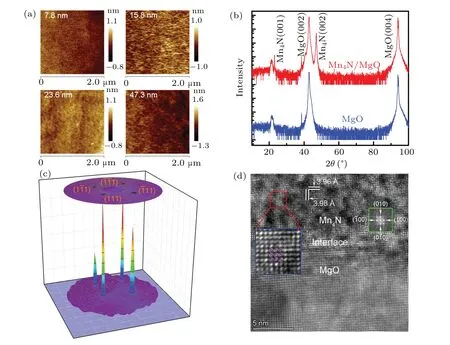
Fig.1. (a)AFM images of the 7.8,15.8,23.6 and 78.8 nm-thick Mn4N films. (b)XRD θ-2θ pattern of the 78.8 nm-thick Mn4N film on the MgO(001)substrate. The XRD pattern of the MgO(001)substrate is shown as a reference. (c)XRD pole figure of the 78.8 nm-thick Mn4N film. (d) Cross-sectional HR-TEM image of the Mn4N/MgO interface of the 78.8 nm-thick Mn4N film. The inset in the green square is the corresponding FFT diffraction image of the area in the red square and The inset in the blue square is the inverse FFT image of the FFT image.
Figure 1(b)shows the XRD patterns of the 78.8 nm-thick Mn4N film and the MgO (001) substrate. Only the diffraction peaks (00l) from the Mn4N film are observed, which suggests that the films grow with a preferred (001) orientation. Based on Bragg’s law, the calculated lattice constant of the Mn4N films is 3.93 °A, which is quite close to 3.87 °A of the Mn4N films prepared by molecular beam epitaxy.[16]Figure 1(c) shows the XRD pole figure of the Mn4N film on the MgO (001) substrate. The pole figure was collected at 2θ=40.365°andαfrom 20°to 90°. Atα=35.3°, there is no peak from the MgO substrate and only the Mn4N(111)peak appears.As seen in Fig.1(c),the strong diffraction peaks(111)indicate the film to be epitaxial.
Figure 1(d) shows the HR-TEM image of the interface between the 78.8 nm-thick Mn4N film and the MgO substrate.The inset in the green square is the fast Fourier transform(FFT)diffraction image of the area labeled by red square. The FFT diffraction image also indicates the epitaxial growth of the Mn4N film,which is consistent with the XRD results. The inset in the blue square is the inverse FFT image of the FFT image,where one can clearly observe the orderly arranged Mn and N atoms, indicating a high-quality growth of the Mn4N film. Purple(Mn atoms)and white(N atom)dots were added to show different atoms. The magnified view of the Mn4N layer indicates thed-spacing of the film to be about 3.98 °A for(100)plane and 3.96 °A for(001)plane. The(001)d-spacing is larger than the XRD results of 3.93 °A,which is attributed to the influence of Mn4N/MgO interface on the structure of the Mn4N film.
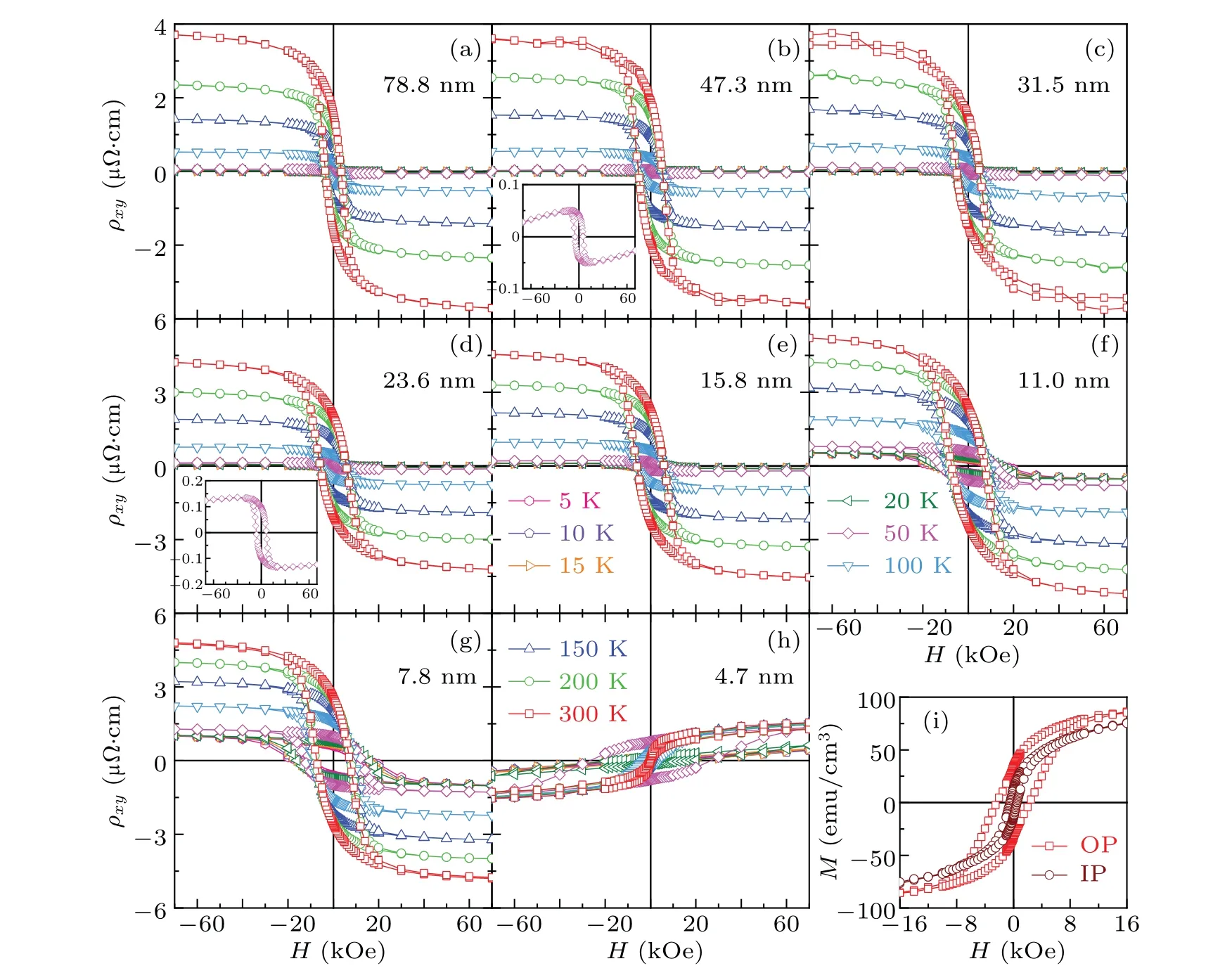
Fig. 2. Magnetic field-dependent Hall resistivity ρxy(H) of the (a) 78.8, (b) 47.3, (c) 31.5, (d) 23.6, (e) 15.8, (f) 11.0, (g) 7.8 and (h) 4.7 nm-thick Mn4N films at different temperatures. (i)M-H curves of the 78.8 nm-thick Mn4N film measured along the in-plane and out-of-plane applied magnetic field at 300 K.
Electronic transport properties of the Mn4N films were investigated in the temperature range of 5-300 K. The Hallbar shaped samples were used for measuring the Hall resistivityρxyof Mn4N films with the thickness of 4.7-78.8 nm.Figures 2(a)-2(h)show theρxy-Hcurves of Mn4N films with different thicknesses at 5-300 K.Figure 2(i)shows theM-Hcurves of the 78.8-nm-thick Mn4N film measured along the inplane and out-of-plane applied magnetic field at 300 K. The hysteresis loops are clearly open in the magnetic field perpendicular to the films, which indicates the PMA of Mn4N films. The hysteresis loops of Hall resistivity show the similar behavior with that of field-dependent magnetization,which is different from the Hall resistivity of Fe4N.[34]The linear field dependence of Hall resistivity in the high-field regions originates from the ordinary Hall effect, which is caused by Lorentz force.[35]The Hall resistivity including ordinary Hall resistivity (ρOH) and anomalous Hall resistivity (ρAH) can be expressed asρxy=ρOH+ρAH=R0H+Rs4πM,whereR0andRsare ordinary and anomalous Hall coefficients,respectively,Mis the magnetization perpendicular to the film plane. TheρOHwas proportional to the applied magnetic field, and its sign follows the type of the charge carriers. The anomalous Hall resistivityρAHis obtained by subtracting the ordinary Hall componentR0Hfrom Hall resistivity by linearly fitting the high-field regions of theρxy-Hcurves, where the slope andy-axis intercept corresponds toR0andρAH, respectively.The insets of Figs. 2(b) and 2(d) display theρxy-Hcurves at 50 K, which shows a positive slope in high-field regions.The variation of slope implies the sign reversal of carrier concentration. The temperature-dependent carrier type transition indicates the change of electronic filling status and the shift of Fermi energy level in a topological structure.[36]The low temperature anomaly of the Hall resistivity is presumed to be caused by the tetragonal crystal field effect due to the structure distortion.[31]Note that theρxy-Hcurves of the 4.7 nm-thick Mn4N film are significantly different from other curves. The hysteresis behavior ofρxyhas disappeared and the sign reversal ofR0from negative to positive.The sign reversal of AHE is related to the change of band structure in the ultrathin films.[37]In addition, the sign reversal has also been observed in other materials such as(Bi1-xMnx)2Se3films.[38,39]
Figure 3(a) displays the temperature-dependentρAHof Mn4N films with 7.8-78.8 nm thicknesses. TheρAHincreases sharply with the increasing temperature at 100-300 K. Below 100 K, theρAHshows weak temperature dependence.TheρAHof the 31.5 nm-thick Mn4N film is 2.698 µΩ·cm at 300 K, which is comparable to the value (2.8 µΩ·cm)for the 35 nm-thick Mn4N film fabricated by pulsed laser deposition[32]and also comparable with the typical PMA materials such asL10-type FePt film(1.7µΩ·cm)and amorphous TbxCo1-x(2µΩ·cm).[40,41]The value ofρAHat room temperature is lower than that of the Fe4N film (14.15 µΩ·cm) due to the higher conductivity.[34]In Fig.3(b),R0is negative,suggesting that electrons dominate transport properties. TheRsdetermined by theρAH/4πMsis displayed in Fig.3(c),which decreases with decreasing temperature monotonically and approaches almost zero at low temperature. Moreover, the carrier mobilityµdefined byµ=R0/ρxxis displayed in Fig.3(d).Theµof Mn4N films with different thicknesses increases with the increasing temperature from 5-50 K,and decreases in the temperature range from 50 to 300 K. The magnitude ofµabout 102cm2/(V·s)in Mn4N is one order larger than that in Mn2PtSn films(30 cm2/(V·s)),[42]which is consistent with the high conductivity of Mn4N films.
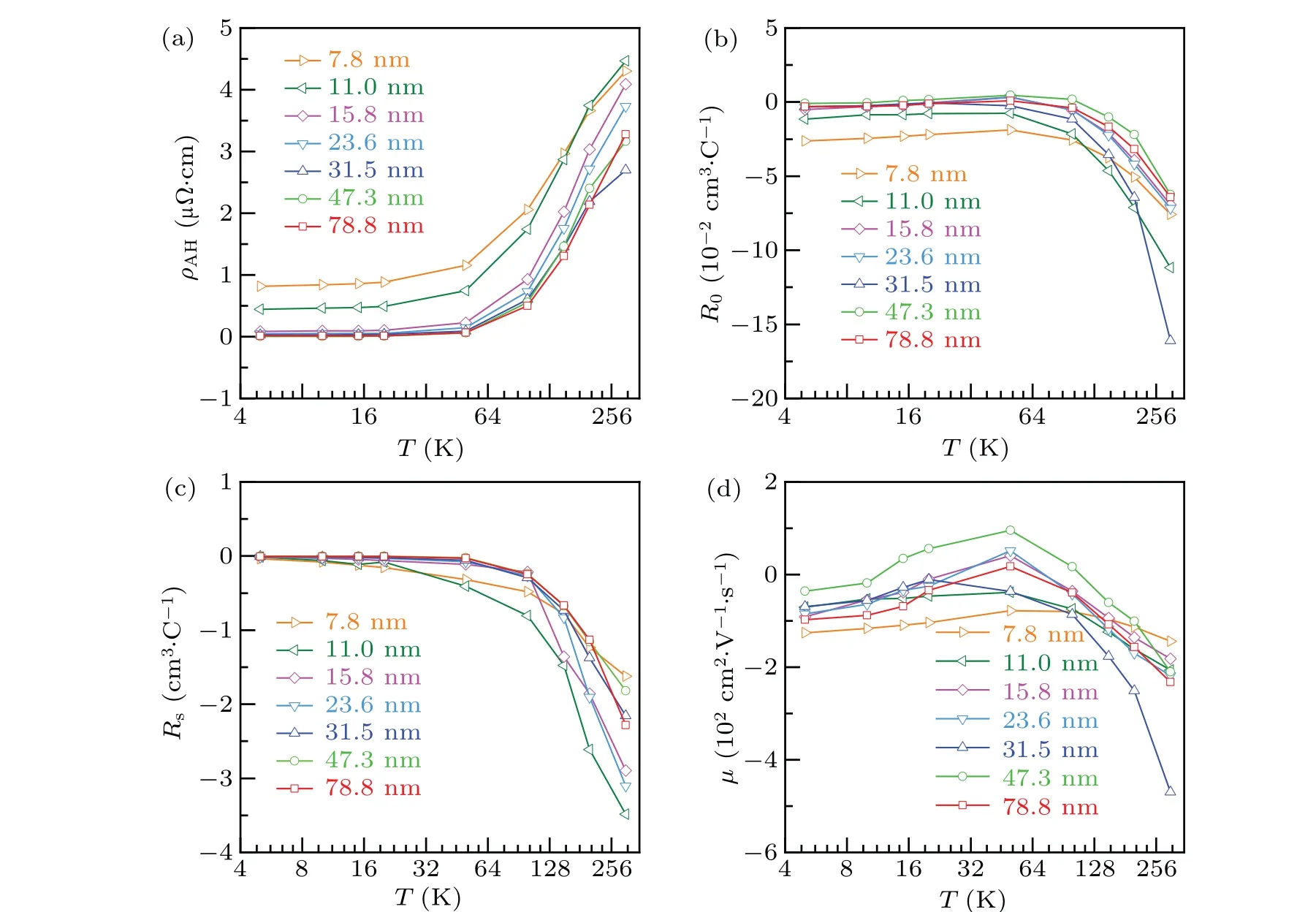
Fig.3. Temperature-dependent(a)ρAH,(b)R0,(c)Rs and(d)µ of Mn4N films with different thicknesses on MgO substrates.
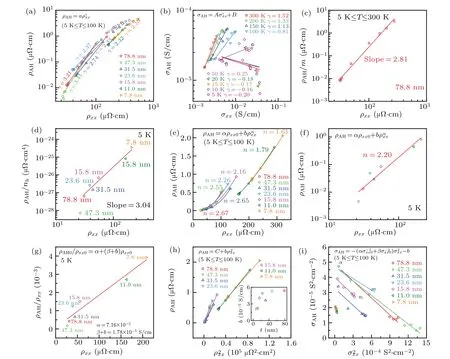
Fig. 4. (a) Relation of logρAH vs. logρxx of Mn4N films with different thicknesses below 100 K, based on the conventional scaling of ρAH=aργxx.(b) Plots of σAH vs. σxx at different measured temperatures with the fitting lines by σAH =Aσγxx+B. (c) Plots of logρAH/m vs. logρxx for the 78.8 nm-thick Mn4N film at 5-300 K. (d) Plots of ρAH/nh vs. ρxx in log-log scale of the Mn4N films with different thicknesses at 5 K. (e) Plots of ρAH vs. ρxx for Mn4N films with different thicknesses below 100 K by the scaling of ρAH =αρxx0+bρnxx. (f)Plots of logρAH vs. logρxx for Mn4N films with different thicknesses at 5 K. (g) Plots of ρAH/ρxx vs ρxx at 5 K, with ρxx0 being the longitudinal resistivity at 5 K, the red line being the linear fit by ρAH0/ρxx0 =α+(β +b)ρxx0. The intercept is parameter α and the slope is (β +b). (h) Plots of ρAH vs. ρ2xx. Inset is the intrinsic contribution b obtained by the slope of fitting lines in(h). (i)The relation between σAH and σ2xx of the Mn4N films with different thicknesses,satisfying the σAH=-(ασ-1xx0+βσ-2xx0)σ2xx-b.
The origin of the AHE mechanism could be characterized by exponential factorγin the conventional scaling ofρAH=aργxx. In order to distinguish the various contributions to the AHE mechanism, theρAH~ρxxrelations of Mn4N films with different thicknesses in a log-log scale are shown in Fig.4(a).TheρAH~ρxxcurves could be fitted to a series of straight lines with slopesγbelow 100 K,yet theρAHdeviates from the linear dependence at higher temperature. The scaling exponentγshows a strong dependence on film thickness.Note thatγis larger than 2 in all the Mn4N films. Generally,the scaling exponentsγof heterogeneous ferromagnetic systems are larger than 2,such asγ=2.6 of Fe/Cr multilayer andγ=3.7 of Co-Ag granular films.[43,44]Moreover,the interfacial scattering dominated AHE could also lead to a largeγ.[45]
The anomalous Hall conductivityσAHversusσxxof Mn4N films with different thicknesses in a log-log scale is displayed in Fig. 4(b), which implies that theσxxfalls into the dirty regime. The fitted exponentγis 1.52 at 300 K.However, the data points are dispersed below 50 K, which indicates that the AHE in Mn4N films cannot be fitted by the scaling law ofσAH=Aσγxx+Bat low temperature. In order to investigate the nonlinear relationship in the high temperature induced by the temperature-dependent magnetization,[46,47]theρAH/mversusρxxof the 78.8 nm-thick Mn4N film in a log-log scale is plotted in Fig. 4(c), wheremis defined asm=Ms(T)/Ms(300 K). The data of log(ρAH/m) versus logρxxcould be well fitted in the temperature region from 5 K to 300 K. The magnetization-dependent AHE scaling law of Mn4N films also implies that only the data below 100 K could be analyzed,where the effect of temperature-dependent magnetization onρAHis negligible. The carriers and impurities govern the different origins of the AHE.In order to determine whether the AHE current is dissipationless, it is necessary to factor out the carrier concentration from Hall resistivity. The dissipationless Hall resistivity confirms that the anomalous velocity origin is topological in nature and is equally valid in the Bloch and localization regimes.[48]The curve of log(ρAH/nh)versus logρxxat 5 K is displayed in Fig.4(d)to investigate the dependence ofρAHonnh. The dissipationlessρAHsatisfies the relationship of (ρAH/nh)∝ρ2xx;α=3.44 at 5 K is obtained by linear fitting,which indicates that theρAHof Mn4N films is scattering-dependent.
Note that the scaling exponentγis larger than 2 in all the films, hence other scaling laws are used to further analyze the AHE mechanism. In order to exclude the contribution of phonons to skew scattering, a proper scaling ofρAH=αρxx0+bρ2xxwas proposed.[49,50]Theρxx0is residual resistivity,which represents the impurity or defects scattering in the film. The scaling constantαis considered to be from skew scattering contributions,while the constantbrepresents the contributions from side-jump and intrinsic mechanism. In the previous report,the scaling ofρAH=αρxx0+bρ2xxshows an excellent agreement with the experimental data.[30]Here,consider the skew scattering contributions in the conventional scaling ofρAH=aργxx, the differences between phonons and impurities or defects could result in the scaling exponentγ >2.Therefore,the revised scaling ofρAH=αρxx0+bρnxxwas first used to separate out the temperature-independentρxx0from different contributions. Figure 4(e)shows the scaling fit well for the Mn4N films with different thicknesses,which confirms the difference between contributions from phonons and impurities. According to the fitting results,the scaling exponents vary from 1.61 to 2.67,indicating that the thickness-dependentρxx0leads to the scaling exponent larger than 2. Note that the scaling exponentn <2 has also been observed, the deviation of scaling exponent from 2 may be associated with the thermal disorder from a relatively skew scattering contribution.[51]Furthermore,in order to clarify the effect of impurity scattering on AHE, the logρAH-logρxxcurve at 5 K with different thicknesses is shown in Fig. 4(f). The slope valuen=2.20 is obtained by linear fitting, indicating that another extrinsic contribution exists besides the skew scattering.[52]

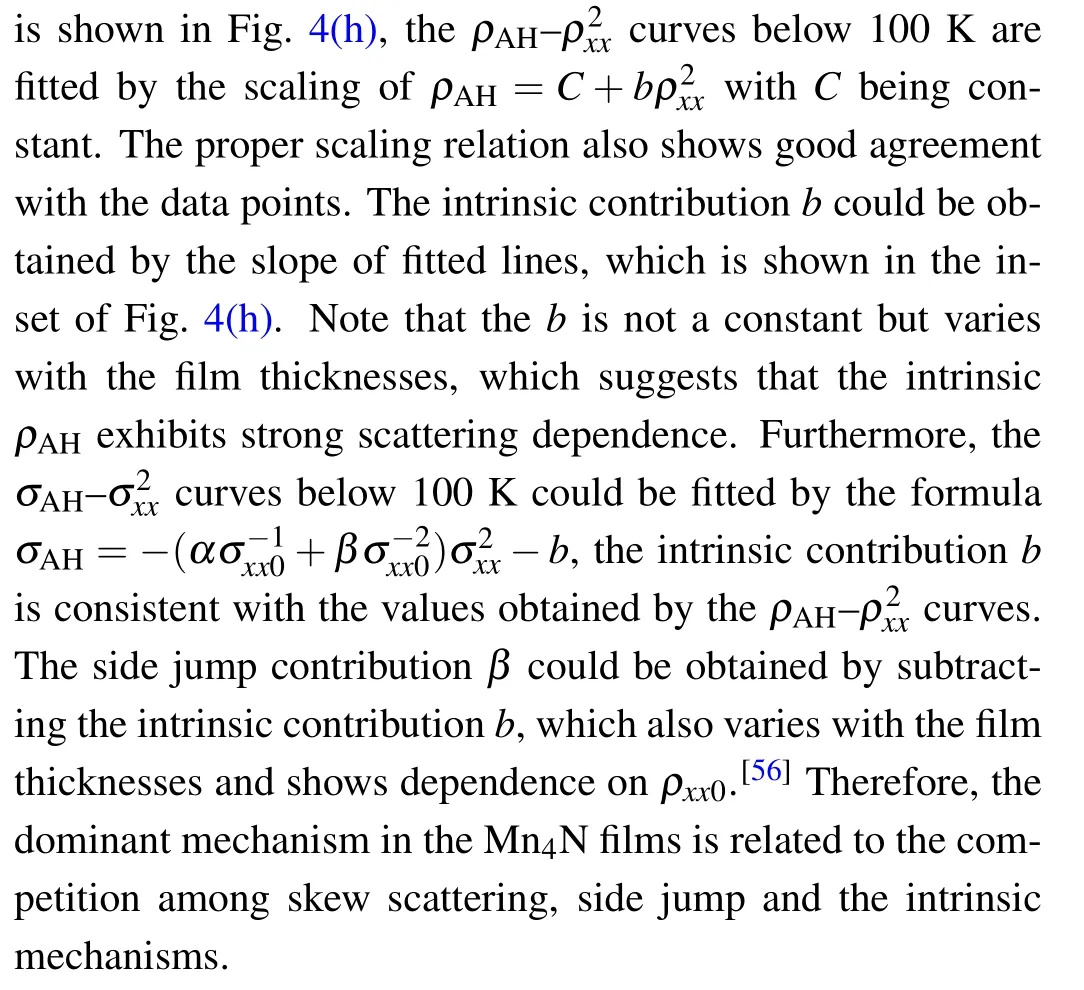
4. Conclusions
In summary,the antiperovskite-type epitaxial Mn4N films with different thicknesses have been deposited on MgO(001)substrates. The Hall resistivity is negative at positive magnetic field and shows a hysteresis behavior. Different scaling laws are used to distinguish the various contributions of AHE mechanisms. The deviation of the conventional scaling relation at high temperature is due to the influence of temperaturedependent magnetization. The anomalous Hall conductivity is scattering-dependent in Mn4N films. The scaling exponentγlarger than 2 for theρAH∝ργxxin Mn4N films with different thicknesses is the result of the contribution fromρxx0.The contributions from extrinsic and intrinsic AHE mechanisms are investigated by the proper scaling. The dominant mechanism of AHE in Mn4N films is related to the competition among skew scattering,side jump and the intrinsic mechanisms.
Acknowledgement
This work was supported by the National Natural Science Foundation of China(Grant Nos.51871161 and 52071233).
杂志排行
Chinese Physics B的其它文章
- Helium bubble formation and evolution in NiMo-Y2O3 alloy under He ion irradiation
- Dynamics and intermittent stochastic stabilization of a rumor spreading model with guidance mechanism in heterogeneous network
- Spectroscopy and scattering matrices with nitrogen atom:Rydberg states and optical oscillator strengths
- Low-overhead fault-tolerant error correction scheme based on quantum stabilizer codes
- Transmembrane transport of multicomponent liposome-nanoparticles into giant vesicles
- Molecular dynamics simulations of A-DNA in bivalent metal ions salt solution
